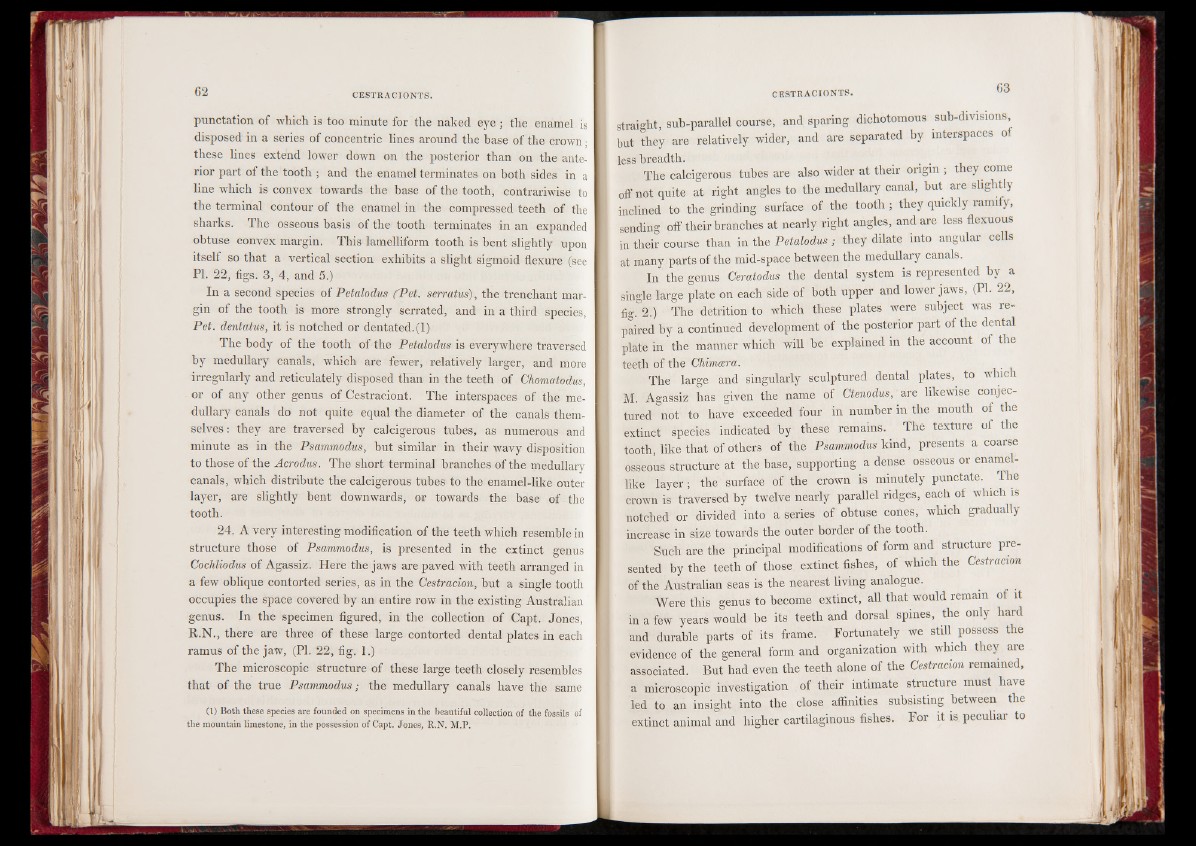
punctation of which is too minute for the naked eye; the enamel is
disposed in a series of concentric lines around the base of the crown;
these lines extend lower down on the posterior than on the anterior
part of the tooth ; and the enamel terminates on both sides in a
line which is convex towards the base of the tooth, contrariwise to
the terminal contour of the enamel in the compressed teeth of the
sharks. The osseous basis of the tooth terminates in an expanded
obtuse convex margin. This lamelliform tooth is bent slightly upon
itself so that a vertical section exhibits a slight sigmoid flexure (see
PL 22, figs. 3, 4, and 5.)’
In a second species of Petalodus CPet. serratus), the trenchant margin
of the tooth is more strongly serrated, and in a third species,
Pet. dentatus, it is notched or dentated.(l)
The body of the tooth of the Petalodus is everywhere traversed
by medullary canals, which are fewer, relatively larger, and more
irregularly and reticulately disposed than in the teeth of Chomatodus,
or of any other genus of Cestraciont. The interspaces of the medullary
canals do not quite equal the diameter of the canals themselves:
they are traversed by calcigerous tubes, as numerous and
minute as in the Psammodus, but similar in their wavy disposition
to those of the Acrodus. The short terminal branches of the medullary
canals, which distribute the calcigerous tubes to the enamel-like outer
layer, are slightly bent downwards, or towards the base of the
tooth.2
4. A very interesting modification of the teeth which resemble in
structure those of Psammodus, is presented in the extinct genus
Cochliodus of Agassiz. Here the jaws are paved with teeth arranged in
a few oblique contorted series, as in the Cestracion, but a single tooth
occupies the space covered by an entire row in the existing Australian
genus. In the specimen figured, in the collection of Capt. Jones,
R.N., there are three of these large contorted dental plates in each
ramus of the jaw, (PI. 22, fig. 1 .)
The microscopic structure of these large teeth closely resembles
that of the true Psammodus; the medullary canals have the same
(l) Both these species are founded on specimens in the beautiful collection of the fossils of
the mountain limestone, in the possession of Capt. Jones, R.N. M.P.
straight, sub-parallel course, and sparing dichotomous sub-divisions
but they are relatively wider, and are separated by interspaces of
less bTrehaed ctha.l cigerous tubes are also wider at their ori. g.in % they come
off not quite at right angles to the medullary canal, but are slightly
inclined to the grinding surface of the tooth ; they quickly rami y,
sending off their branches at nearly right angles, and are less flexuous
in their course than in the Petalodus; they dilate into angular cells
at many parts of the mid-space between the medullary canals.
In the genus Ceratodus the dental system is represented by a
single large plate on each side of both upper and lower jaws, (PL 22,
fig. 2.) The detrition to which these plates were subject was repaired
by a continued development of the posterior part of the dental
plate in the manner which will be explained in the account of the
teeth of the Chimcera.
The large and singularly sculptured dental plates, to which
M. Agassiz has given the name of Ctenodus, are likewise conjectured
not to have exceeded four in number in the mouth of the
extinct species indicated by these remains. The texture of the
tooth, like that of others of the Psammodus kind, presents a coarse
osseous structure at the base, supporting a dense osseous or enamellike
layer; the surface of the crown is minutely punctate. The
crown is traversed by twelve nearly parallel ridges, each of which is
notched or divided into a series of obtuse cones, which gradually
increase in size towards the outer border of the tooth.
Such are the principal modifications of form and structure presented
by the teeth of those, extinct fishes, of which the Cestracion
of the Australian seas is the nearest living analogue.
Were this genus to become extinct, all that would remain of it
in a few years would be its teeth and dorsal spines, the only hard
and durable parts of its frame. Fortunately we still possess the
evidence of the general form and organization with which they are
associated. But had even the teeth alone of the Cestracion remained,
a microscopic investigation of their intimate structure must have
led to an insight into the close affinities subsisting between the
extinct animal and higher cartilaginous fishes. For it is peculiar to